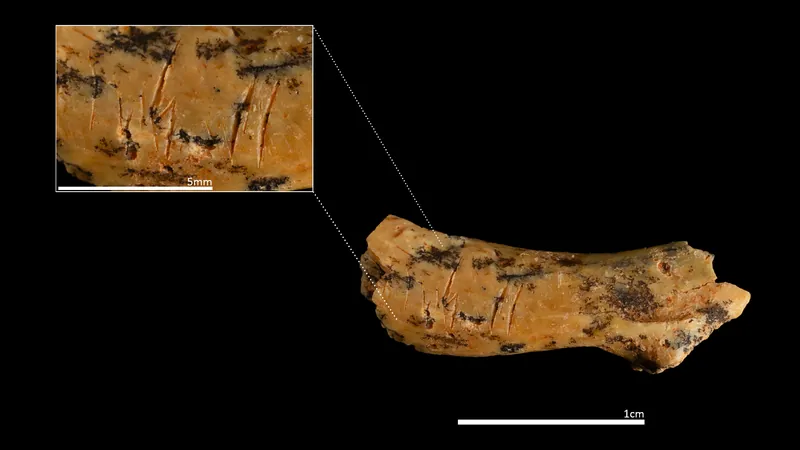
Revolutionizing Genome Editing: New Software Makes CRISPR Accessible to All Researchers
2025-07-07
Author: Charlotte
Unlocking the Power of CRISPR for Everyone
A groundbreaking new software tool is set to democratize the world of genome editing, making it more accessible than ever to researchers across the life sciences. Developed by Eric Malekos, a Ph.D. student in biomolecular engineering at the University of California, Santa Cruz, this innovative program—dubbed CRISPRware—integrates seamlessly into the widely-used UCSC Genome Browser.
What is CRISPRware?
CRISPRware simplifies the precision editing process involved in developing therapies for genetic disorders such as sickle cell anemia. Named after the CRISPR-Cas9 system, a tool revolutionizing genetic research, CRISPRware allows users to design guide RNAs tailored to target specific genome regions—offering solutions for both common and less-studied sequences.
Addressing Current Limitations in Genome Editing
The power of CRISPR technology is often hampered by its reliance on short binding sequences within guide RNAs, limiting its utility in less-characterized areas of the genome. Malekos recognized this gap and took action, creating CRISPRware to identify optimal guide RNAs across all genomic regions, thus empowering researchers to explore uncharted territories.
The Impact of Small Peptides
Though they are tiny, small peptides can have monumental effects on our health. For example, glucagon-like peptide-1, only about 60 amino acids long, is crucial for regulating blood sugar and appetite. These peptides hold key secrets about our innate immune system and inflammatory responses, and Malekos’s research looks to decode them further with CRISPRware.
Integrating Knowledge and Tools
CRISPRware doesn’t just make the genome-editing process more approachable; it enhances collaboration within the scientific community. Susan Carpenter, professor of molecular, cell, and developmental biology, emphasized that by embedding CRISPRware into the UCSC Genome Browser—used daily by thousands—researchers without bioinformatics training can leverage its capabilities.
A Milestone in Gene Therapy
The potential of CRISPRware shines through in recent advancements, like the successful application of CRISPR-based personalized gene therapy for carbamoyl phosphate synthetase 1 (CPS1) deficiency. This breakthrough highlights how tools like CRISPRware can pave the way for future innovations in genetic treatments.
Breaking Down Barriers
Traditional bioinformatics tools can be daunting for non-specialists, but CRISPRware’s user-friendly design enables researchers to efficiently browse precomputed guide RNA libraries. This accessibility encourages scientists from all backgrounds to dive into genome editing, enhancing collaboration and discovery.
Systematic Screening for Hidden Proteins
In a significant leap, CRISPRware facilitates high-throughput screening, enabling researchers to analyze thousands of candidate peptides simultaneously—crucial for uncovering the mysteries of the so-called 'dark proteome'.
Validated Across Multiple Species
To ensure its reliability, CRISPRware has been tested on the genomes of six model organisms including humans, mice, and fruit flies. Malekos’s tool generates comprehensive catalogs of guide RNAs, making it an invaluable resource for researchers in diverse fields.
A Step Forward for Biomedical Research
Published in BMC Genomics, the development of CRISPRware—supported by prestigious fellowships and grants—reflects a significant investment in cutting-edge research aimed at advancing precision medicine. With this tool in hand, the horizons of genome editing are set to broaden, inviting more scientists into this groundbreaking field.









 Brasil (PT)
Brasil (PT)
 Canada (EN)
Canada (EN)
 Chile (ES)
Chile (ES)
 Česko (CS)
Česko (CS)
 대한민국 (KO)
대한민국 (KO)
 España (ES)
España (ES)
 France (FR)
France (FR)
 Hong Kong (EN)
Hong Kong (EN)
 Italia (IT)
Italia (IT)
 日本 (JA)
日本 (JA)
 Magyarország (HU)
Magyarország (HU)
 Norge (NO)
Norge (NO)
 Polska (PL)
Polska (PL)
 Schweiz (DE)
Schweiz (DE)
 Singapore (EN)
Singapore (EN)
 Sverige (SV)
Sverige (SV)
 Suomi (FI)
Suomi (FI)
 Türkiye (TR)
Türkiye (TR)
 الإمارات العربية المتحدة (AR)
الإمارات العربية المتحدة (AR)